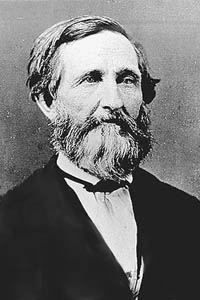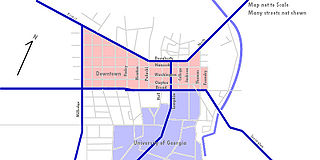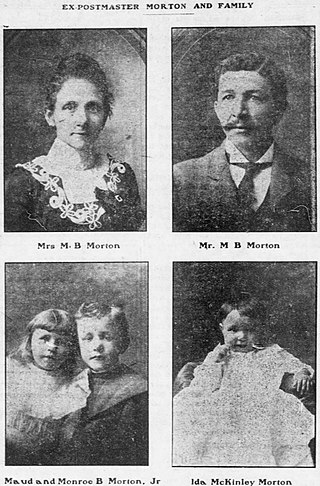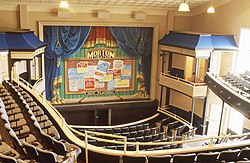
Athens is a consolidated city-county and college town in the U.S. state of Georgia. Downtown Athens lies about 70 miles northeast of, or about one hour from, downtown Atlanta. The University of Georgia, the state's flagship public university and an R1 research institution, is in Athens and contributed to its initial growth. In 1991, after a vote the preceding year, the original City of Athens abandoned its charter to form a unified government with Clarke County, referred to jointly as Athens–Clarke County where it is the county seat.

Crawford Williamson Long was an American surgeon and pharmacist best known for his first use of inhaled sulfuric ether as an anesthetic.
Theatre Owners Booking Association, or T.O.B.A., was the vaudeville circuit for African American performers in the 1920s. The theaters mostly had white owners, though there were exceptions, including the recently restored Morton Theater in Athens, Georgia, originally operated by "Pinky" Monroe Morton, and Douglass Theatre in Macon, Georgia owned and operated by Charles Henry Douglass. Theater owners booked jazz and blues musicians and singers, comedians, and other performers, including the classically trained, such as operatic soprano Sissieretta Jones, known as "The Black Patti", for black audiences.

The Sweet Auburn Historic District is a historic African-American neighborhood along and surrounding Auburn Avenue, east of downtown Atlanta, Georgia, United States. The name Sweet Auburn was coined by John Wesley Dobbs, referring to the "richest Negro street in the world," one of the largest concentrations of African-American businesses in the United States.
The music of Athens, Georgia includes a wide variety of popular music and was an important part of the early evolution of alternative rock and new wave. The city is well known as the home of chart-topping bands like R.E.M., Widespread Panic, The B-52's, and several long-time indie rock groups. Athens hosts the Athens Symphony Orchestra and other music institutions, as well as prominent local music media, such as the college radio station WUOG. Much of the modern Athens music scene relies on students from the large University of Georgia campus in the city. The University sponsors Western classical performances and groups specializing in other styles.

Downtown Athens is the oldest of the main commercial and residential centers in Athens, Georgia, United States. Downtown is generally considered to be the area bounded by Dougherty Street on the north, Broad Street and the University of Georgia campus on the south, Pulaski Street on the west, and Foundry Street by the east.

The Palace Theatre is a stage production venue at 76-96 Hanover Street in Manchester, New Hampshire, United States. Built in 1914, the theatre was listed on the National Register of Historic Places as the Athens Building.

The Madam C. J. Walker Building, which houses the Madam Walker Legacy Center, was built in 1927 in the city of Indianapolis, in the U.S. state of Indiana, and as Madam C. J. Walker Manufacturing Company, it was designated a National Historic Landmark in 1991. The four-story, multi-purpose Walker Building was named in honor of Madam C. J. Walker, the African American hair care and beauty products entrepreneur who founded the Madam C. J. Walker Manufacturing Company, and designed by the Indianapolis architectural firm of Rubush & Hunter. The building served as the world headquarters for Walker's company, as well as entertainment, business, and commercial hub along Indiana Avenue for the city's African American community from the 1920s to the 1950s. The historic gathering place and venue for community events and arts and cultural programs were saved from demolition in the 1970s. The restored building, which includes African, Egyptian, and Moorish designs, is one of the few remaining African-Art Deco buildings in the United States. The Walker Building was added to the National Register of Historic Places in 1980.
Chicopee-Dudley is a primarily residential neighborhood in Athens, Georgia, located east of the city's Downtown. The neighborhood, as officially defined, straddles the North Oconee River between Third Street and Oconee Street; however, the majority of the neighborhood's territory, landmarks, and population exist to the east of the river.

The Balboa Theatre is an historic vaudeville/movie theatre in downtown San Diego, California, US, built in 1924. Listed on the National Register of Historic Places in 1996, the Balboa was refurbished and reopened as a performing arts venue in 2008.

The Rialto Center for the Arts is an 833-seat performing-arts venue owned and operated by Georgia State University and located in the heart of the Fairlie-Poplar district in downtown Atlanta, Georgia. The venue is home to the Rialto Series, an annual subscription series featuring national and international jazz, world music, and dance. The Rialto also routinely presents Georgia State University School of Music performances, the annual National Black Arts Festival, and many others.

The Monroe Avenue Commercial Buildings, also known as the Monroe Block, is a historic district located along a block-and-a-half stretch at 16-118 Monroe Avenue in Detroit, Michigan, just off Woodward Avenue at the northern end of Campus Martius. The district was designated a Michigan State Historic Site in 1974 and listed on the National Register of Historic Places in 1975. The thirteen original buildings were built between 1852 and 1911 and ranged from two to five stories in height. The National Theatre, built in 1911, is the oldest surviving theatre in Detroit, a part of the city's original theatre district of the late 19th century, and the sole surviving structure from the original Monroe Avenue Commercial Buildings historic period.

The Downtown Athens Historic District is a historic area in the Downtown Athens neighborhood of Athens, Georgia. It was listed on the National Register of Historic Places in 1978. Its boundaries were revised twice, in 1984 and 2006, and additional documentation was filed in 2006.
The Progressive Era was an African American newspaper published in Athens, Georgia. It was established in 1899. The Library of Congress has a collection of the paper on microfilm. It was purchased by Monroe Morton in 1914 from W. D. Johnson, A. M. E. Bishop, and W. H. Harris, a dentist whose office was in the Morton Building. Morton served as editor and publisher. No known editions from his tenure have survived.

The Franklin House is a three-story brick historic building located at 464-480 East Broad Street, in Athens, Georgia. It was built in three phases between 1845 and 1860. Originally a mercantile building with an antebellum hotel on the upper floors, from 1865 to 1972 it was a hardware store. In the 1970s it was listed on the National Register of Historic Places, and in the 1980s it was restored and turned into office space and apartments.

Gospel Pilgrim Cemetery was founded in 1882 as a cemetery for African Americans in the 216th general militia district, Athens, Georgia area. Nine acres in size, it contains an estimated 3,500, mostly unmarked, graves.

Monroe Bowers Morton, nicknamed Pink Morton was a prominent building owner, publisher, building contractor, developer, and postmaster in late 19th-century Georgia. An African American, he lived most of his life in Athens, Georgia, where he published a newspaper and built the Morton Building. The building included the Morton Theatre on its upper floors, a vaudeville venue, and offices for African-American professionals including doctors and druggists (pharmacists) on its ground floor. Occupants included Dr. Ida Mae Johnson Hiram, the first Black woman to be licensed to practice medicine (dentistry) in the state, and Dr. William H. Harris, one of the founders of the Georgia State Medical Association of Colored Physicians, Dentists and Druggists.

Knox Institute and Industrial School was a private elementary and secondary school in Athens, Georgia for African Americans. It was open from 1868 until 1928. Alumni include Monroe Morton, a builder and real estate businessman whose legacy includes the Morton Building in Athens, and Charles W. Chappelle. The school was named for Major John J. Knox of the Freedmen's Bureau. The federal agency helped fund the school. Athens' first African American Postmaster, Madison Davis, was one of those who helped purchase property for the school.
Madison "Mat" Davis was a slave who became a member of the Georgia Assembly representing Clarke County, Georgia and the first African American postmaster in Athens, Georgia, after being emancipated. He was active in Republican Party politics.

The First African Methodist Episcopal Church, formerly known as Pierce’s Chapel, is an AME church established in 1866 by Rev. Henry McNeal Turner, and located at 521 North Hull Street in Athens, Georgia.


















